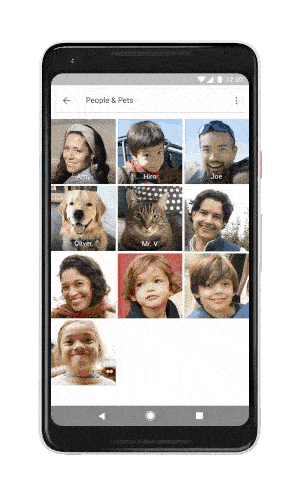
One of the most useful features of Google Photos, face grouping, has landed the company in hot water in the State of Illinois, where a settlement will see Google paying out $100 million.
Google Photos face grouping: Why it violated an Illinois law
As reported by Gizmodo last week, Google settled on this $100 million class-action lawsuit in Illinois because it broke the “Biometric Information Privacy Act.” How?
Face Grouping in Google Photos has been around for several years at this point. It uses the facial features of a user’s face to recognize that face within a photo and group any pictures or videos that include that person into a single digital bucket. The technology even works for pets, as pictured below.
While that’s genuinely useful, the plaintiff in this case argued that the behavior broke the Illinois law. That law requires any private company collecting biometric data – including a face scan – to have a public policy on how long that data is held by the company, and how that data is destroyed. In Google’s case, the problem was that Google wasn’t informing users that biometric data – the photo of their face – was being collected.
The plaintiff explains:
Google is actively collecting, storing, and using—without providing notice, obtaining informed written consent or publishing data retention policies—the biometrics of millions of unwitting individuals whose faces appear in photographs uploaded to Google Photos in Illinois. Specifically, Google has created, collected and stored, in conjunction with its cloud-based ‘Google Photos’ service, millions of ‘face templates’ (or ‘face models’)—highly detailed geometric maps of the face—from millions of Google Photos users.
True to the lawsuit, Google is collecting, storing, and using that information in the Photos app, and it doesn’t provide notice of the activity to the subject of the photos where that information is gathered and used, only to the photographer.

Google Photos Face grouping gets a retention policy
But notably, Google have a support page detailing the retention policy for face grouping data, though it’s likely this was published after the lawsuit hit. As far as we can tell, the page went live around mid-May 2022.
Google explains how it handles this data on that page, saying in essence that when a photo is deleted, so are any face models from that photo, and that deleting your Google account will also delete all face models. This policy seems to be in line with the Illinois law.
If you delete an individual photo or video, you delete any face models derived specifically from that photo or video. If your Google Photos account is inactive for more than 2 years, all of your face grouping content will be deleted from Google Photos…
Turning off face grouping also purges this data from your account.
Illinois residents could get paid by Google
The result of this lawsuit is a $100 million settlement, set to be paid out to residents of the State of Illinois who appeared in a picture uploaded to Google Photos between the dates of May 1, 2015 and April 25, 2022.
Users affected, which is certainly a large number, can mail in a claim form before September 24, 2022 to be paid a portion of the settlement. The final payout will vary depending on how many people actually submit claims, but one estimate believes up to $400 per person could be paid out.
9to5Google’s Take
Is Google actually in the wrong here? Technically yes, but it’s a weird situation.
Google Photos does indeed group faces based on a user’s appearance, and it does that without consent. However, this happens only on a user’s account. If you take a photo of your spouse or friend several times, Google Photos will recognize that and put everything into one group based on the person’s face. You, as the owner of that photo, can then assign a name or contact to that group of pictures. That assigned face doesn’t affect anyone else’s account or show on a public level.
So, it really only seems to be a matter of upfront information that’s the problem here. For any other tool, I’d imagine this would be the photographer’s responsibility, but since this is automatic in Google Photos, it’s almost certain that a huge number of users don’t even know it’s happening.
Whatever the case, this is certainly a weird situation, as face grouping in Google Photos hurts no one in its current implementation. I’m curious if Apple will be in a similar situation, given it does the exact same thing in the native iOS Photos app.
More on Google Photos:
- Google Photos now surfacing ‘Best of Spring 2022’ Memory collection
- ChromeOS Gallery app is gaining Google Photos integration for easy editing
- Google Photos adds new filters to better reflect your skin’s ‘Real Tone’
Author: Ben Schoon
Source: 9TO5Google



